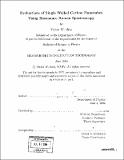| dc.contributor.advisor | Mildred Dresselhaus. | en_US |
| dc.contributor.author | Brar, Victor W. (Victor Watson), 1981- | en_US |
| dc.contributor.other | Massachusetts Institute of Technology. Dept. of Physics. | en_US |
| dc.date.accessioned | 2006-05-15T20:27:58Z | |
| dc.date.available | 2006-05-15T20:27:58Z | |
| dc.date.copyright | 2004 | en_US |
| dc.date.issued | 2004 | en_US |
| dc.identifier.uri | http://hdl.handle.net/1721.1/32759 | |
| dc.description | Thesis (S.B.)--Massachusetts Institute of Technology, Dept. of Physics, 2004. | en_US |
| dc.description | Includes bibliographical references (p. 77-81). | en_US |
| dc.description.abstract | This work reports the results of two studies which use resonance Raman scattering to evaluate the vibrational properties of single walled carbon nanotubes (SWNTs). In the first study, we report an evaluation of second-order combination and over-tone modes in highly ordered pyrolytic graphite (HOPG), in SWNT bundles, and in isolated SWNTs. We found both dispersive and non-dispersive Raman bands in the range 1650-2100 cm⁻¹, and we show that the appearance and frequency vs. laser energy E[laser] behavior of these features are in agreement with predictions from double resonance Raman theory. In the case of SWNTs, these second-order bands depend on the one-dimensional structure of SWNTs, and, at the single nanotube level, the spectra vary from tube to tube, depending on tube diameter and chirality, and on the energy of the van Hove singularity relative to E[laser]. In the second study, we present a theoretical method of predicting, to within a linear constant [beta], the frequency shift in the Raman features of a SWNT material as the Fermi level is changed by depletion or addition of electrons. This constant is then evaluated for different Raman modes in SWNTs by comparing theoretical predictions to experimental observations by Corio et al. , where the Fermi level of SWNT bundles is raised by electrochemical doping and Raman spectra are collected in situ. It is determined that for the G-band of SWNTs, the dependence of frequency on Fermi energy is /[beta][sub]G = 271cm⁻¹ per hole per C-atom for metallic SWNTs with d[sub]f [approximately]= 1.25 ± 0.20nm. | en_US |
| dc.description.statementofresponsibility | by Victor W. Brar. | en_US |
| dc.format.extent | 81 p. | en_US |
| dc.format.extent | 3722242 bytes | |
| dc.format.extent | 3725797 bytes | |
| dc.format.mimetype | application/pdf | |
| dc.format.mimetype | application/pdf | |
| dc.language.iso | eng | en_US |
| dc.publisher | Massachusetts Institute of Technology | en_US |
| dc.rights | M.I.T. theses are protected by copyright. They may be viewed from this source for any purpose, but reproduction or distribution in any format is prohibited without written permission. See provided URL for inquiries about permission. | en_US |
| dc.rights.uri | http://dspace.mit.edu/handle/1721.1/7582 | |
| dc.subject | Physics. | en_US |
| dc.title | Evaluations of single walled carbon nanotubes using resonance Raman spectroscopy | en_US |
| dc.type | Thesis | en_US |
| dc.description.degree | S.B. | en_US |
| dc.contributor.department | Massachusetts Institute of Technology. Department of Physics | |
| dc.identifier.oclc | 56769978 | en_US |
